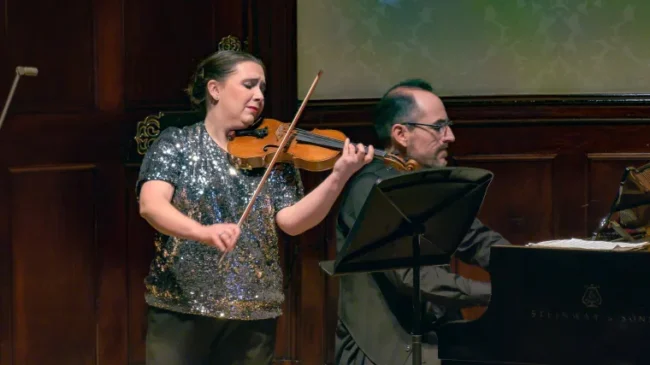 United Kingdom Bach, Shostakovich: Chloё Hanslip (violin), Danny Driver (piano). Turner Sims Concert Hall, Southampton, 10.6.2025. (CK)
United Kingdom Bach, Shostakovich: Chloё Hanslip (violin), Danny Driver (piano). Turner Sims Concert Hall, Southampton, 10.6.2025. (CK)
Bach – Sonata for Violin & Keyboard in E, BWV1016; Sonata for Violin & Keyboard in A, BWV 1015
Shostakovich – Twenty-Four Preludes, Op.34 (selection, arr. violin/piano); Sonata for Violin & Piano in G, Op.134
Chloё Hanslip and Danny Driver received a warm welcome at this, their second of three concerts entitled Bach and Beyond, in which they are playing Bach’s six Sonatas for Violin and Keyboard and exploring connections with other music. Back in March, the Sonatas in B minor and F minor were paired with Sonatas by Franck and Ysaÿe; this concert took a different direction, pairing Bach’s Sonatas in E and A with works by Shostakovich. David Truslove, in his excellent programme note, pointed up the primary contrast between the two: ‘While Bach’s music seems to stand at one remove from contemporary concerns and engage with eternity, the music of Shostakovich – to borrow from Nietzsche – “bears the imprint of its time like an open wound”.’
And indeed, in Bach’s E major Sonata it was sublimity from the start, the violin spinning a meditative line that (Truslove again) ‘would not be out of place in the St Matthew Passion’. The ensuing Allegro was given light and shade by Hanslip’s lovely variations of dynamic; and after the calm, purposeful gait of the Andante the concluding Presto was sparkling, playful, bowling along on a cheerful moto perpetuo on the piano.
I had not previously come across Shostakovich’s 24 Preludes for piano, written in his twenties; Hanslip and Driver played a selection of them (I counted 7) arranged for violin and piano. As we might expect from the heady years before the composer first fell foul of Stalin and his apparatchiks, the music is full of quirkiness and comedic energy. Hanslip characterised them adroitly, brilliantly, finding feeling and grace as well as grotesquerie and nose-thumbing cheekiness: it was tempting to hear in the music a Portrait of the Artist as a Young Man.
The opening Andante of Bach’s Sonata in A is almost as beautiful as the Adagio of the Sonata in E. It was most beautifully played; for some reason, as it unfolded, I had a yen to hear it on harpsichord rather than piano. The Allegro brought virtuoso playing from Hanslip, and the gravity of the second Andante seemed to breathe the same air as the famous Air in the Third Orchestral Suite (which Bach borrowed, of course, from Procol Harum). The final Presto was irresistible, both players light-fingered.
Shostakovich’s Violin Sonata in G is a very different proposition from the early Preludes. Its opus number places it between the Twelfth and Thirteenth String Quartets, and with the last two symphonies: bleak territory. It was written as a gift to David Oistrakh on his 60th birthday; but there is nothing celebratory in this dark, austere, unflinching music. Driver gave us a useful introduction to its background and its processes.
The opening Andante is spacious, wide-ranging, predominantly chilly, eventually petering out indeterminately. The Allegretto is a real tour de force for both players. In his introduction Driver advised us to think of tanks parading in Red Square: pitiless, unstoppable power. The music is far from easy on the listener’s ear: something of an endurance test for players and audience alike – more so, perhaps, than even those vicious Allegros in the Eighth and Tenth Symphonies. The finale opens in uncompromising mood. A passacaglia theme in bare violin pizzicato, a ghostly Mahlerian march, initiating a set of variations which take the listener through contrasting territories of the mind: some of them quiet, and bare, but culminating in a demonic cadenza for piano, followed by another for violin. Ingratiating? No. Compelling? Yes.
The music ebbs and eventually returns to its opening. There is a sense of homecoming, but it does not bring joy or relief: perhaps a sense of uneasy, provisional peace. Weird high sounds on the violin, low chords on the piano like distant storm-clouds.
The reception was as warm as the music was chilly. Hanslip and Driver were called back four times after their initial curtain-call. ‘Hard to follow that’, said Driver, adding ‘You are a generous audience – we love coming here’. They played the Serenade from Stravinsky’s Suite Italienne (arranged from Pulcinella): it was beautifully done, Stravinsky’s lightness and elegance by no means unwelcome after the forbidding tundra of late Shostakovich.
Chris Kettle
Featured Image: Violinist Chloё Hanslip and pianist Danny Driver in a previous concert at The Wigmore Hall © The WH Trust
